cocoaNEC includes a set of extensions to NEC. It includes terminations, physical coax and twin-lead models and wire insulations.
Terminations
The diagram below shows the relationship between a source, a load and a transmission line when they are placed in the same segment of a wire in NEC.
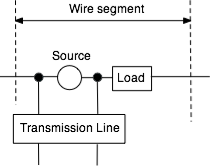
cocoaNEC provides an NC function that allows you to insert a "termination" into a segment that is placed in parallel with a source or a transmission line that is in the same segment, instead of being in series with them.
impedanceTermination( element, R, X )
- impedanceTermination places an impedance R+iX at the center of the wire element, such that it terminates (shunts) both a source at that segment and a transmission line at that segment of the wire, as shown below:
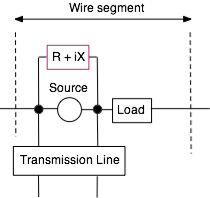
- lumpedParallelTermination places a resistor, inductor and capacitor at the center of the wire element, such that it terminates (shunts) both a source at that segment and a transmission line at that segment of the wire, as shown below:
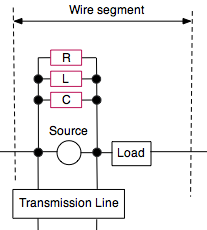
- lumpedSeriesTermination places a series connected resistor, inductor and capacitor at the center of the wire element, such that the combination terminates (shunts) both a source at that segment and a transmission line at that segment of the wire, as shown below:
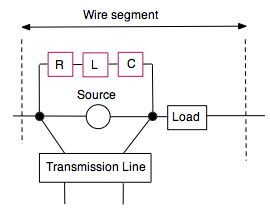
Physical Coax and Twin-lead Transmission Lines.
The NC transmissionLine function generates a NEC TL card to insert a transmission line between two wire elements. While you can model the characteristic impedance and velocity factor, a TL card does not model DC losses, skin effect losses or dielectric losses. The TL card also does not physically exist, and only models voltage and currents at the ends of the line.
Just as wires in NC have the type element, a coax or twin-lead in NC has a type coaxtype. And, like wire elements, you can assign a coaxtype variable to another. Some examples of how coaxtype variables and constants can be used are shown here:
model ( "coaxtype example" )
{element e1, e2 ;
}
coaxtype mycoax ;
e1 = wire( 0, -5, 12, 0, 5, 12, 0.01, 21 ) ;
e2 = wire( 4, -5, 12, 4, 5, 12, 0.01, 21 ) ;
mycoax = RG58 ; // RG58 is a built-in constant
coax( e1, e2, RG58 ) ;
coax( e1, e2, mycoax ) ; // this line should do the same thing as the previous line
The next two sections describe built-in coaxtype constants for some common coax cables and window lines. These constants can be used anywhere a coaxtype variable can be used.
Coax Cable Types
The following are (case sensitive) manifest constants for coax cables in NC. coaxtype Nom. Zo Velocity Factor Manufacturer Type RG6 75 Ω 0.66 Belden 8215 RG6hdtv 75 Ω 0.83 Belden 7915A RG6catv 75 Ω 0.83 Belden 9116 RG8 52 Ω 0.66 Belden 8237 RG8foam 50 Ω 0.82 Belden 9914 RG8X 50 Ω 0.82 Belden 9258 RG11 76 Ω 0.66 Belden 9212 RG11foam 75 Ω 0.84 Belden 8213 RG58 51.5 Ω 0.66 Belden 8240 RG58foam 53.5 Ω 0.73 Belden 8219 RG59 75 Ω 0.66 Belden 8241 RG59foam 75 Ω 0.78 Belden 8212 RG62 90 Ω 0.84 Belden 9269 RG174 50 Ω 0.66 Belden 8216 RG213 50 Ω 0.66 Belden 8267 LMR100 50 Ω 0.66 Times Microwave LMR®-100A LMR200 50 Ω 0.83 Times Microwave LMR®-200 LMR240 50 Ω 0.84 Times Microwave LMR®-240 LMR300 50 Ω 0.85 Times Microwave LMR®-300 LMR400 50 Ω 0.85 Times Microwave LMR®-400 LMR600 50 Ω 0.87 Times Microwave LMR®-600 LMR900 50 Ω 0.87 Times Microwave LMR®-900 BuryFLEX 50 Ω 0.82 Davis RF Bury-FLEX™ LDF4 50 Ω 0.88 Andrew LDF4-50A Heliax® LDF5 50 Ω 0.89 Andrew LDF5-50 Heliax® LDF6 50 Ω 0.89 Andrew LDF6-50 Heliax®
Twin Lead Types
The following are (case sensitive) manifest constants for twin-lead cables which are defined in NC. coaxtype Zo Velocity Factor Wire Gauge Nom. Zo Generic450ohm 450 Ω 0.91 Generic600ohm 600 Ω 0.97 Wireman551 400 Ω 0.902 18 AWG solid 450 Ω Wireman551wet 390 Ω 0.864 18 AWG solid 450 Ω Wireman552 380 Ω 0.918 16 AWG stranded 450 Ω Wireman552wet 365 Ω 0.883 16 AWG stranded 450 Ω Wireman553 395 Ω 0.902 18 AWG stranded 450 Ω Wireman553wet 380 Ω 0.869 18 AWG stranded 450 Ω Wireman554 360 Ω 0.93 14 AWG stranded 440 Ω Wireman554wet 350 Ω 0.87 14 AWG stranded 440 Ω
Defining other coaxtypes
You can define your own coaxtype by calling and assigning the coaxModel function to a coaxtype variable:
coaxModel( Zo, velocityFactor, k0, k1, k2, shieldDiameter, overallDiameter, jacketPermittivity )
- Zo and velocityFactor are the known characteristic impedance and velocity factor of the cable,
k0 accounts for the DC resistance/length of the conductors,
k1 accounts for the high frequency resistance/length of the conductors due to skin effect,
k2 is the dielectric loss,
shieldDiameter is the diameter (in meters) of the coax shield,
overallDiameter is the overall diameter of the coax cable (including the outer jacket),
jacketPermittivity is the relative permittivity of jacket material (about 3.2 for PVC and 2.25 for Polyethylene)
The shield diameter, overall diameter and jacket material values can be obtained from the manufacturer's specifications. The shield diameter is only used in NC functions that models the shield. When used with functions that ignores the shield, the shieldDiameter can be set to zero.
If the overall diameter is equal to or less than the shield diameter, the shield is assumed to be in free space, otherwise a Yurkov insulation approximation is applied to the wire which models the shield.
Sources other than AC6LA may approximate the frequency-independent DC loss (k0) by curve fitting it into the skin effect loss (k1). If that is the case, set the k0 term to zero. Separating k0 and k1 provides a better approximation of cable characteristics below about 10 MHz.
Note that the transmission line loss constants k0,k1 and k2 are expressed in length units of meters. AC6LA's Transmission Line Details expresses lengths in units of 100 feet. The k0,k1 and k2 constants from AC6LA's program must be multiplied by 0.0328084 (the number of feet in 1 meter, divided by 100) when used in the coaxModel function.
For example, the Belden 8216 (RG-174) can be defined and used to create a cable that connects two wire elements as follows:
{
- element e1, e2 ;
coaxtype myRG174 ;
e1 = wire( 0, -5, 12, 0, 5, 12, 0.01, 21 ) ;
e2 = wire( 4, -5, 12, 4, 5, 12, 0.01, 21 ) ;
myRG174 = coaxModel( 50, 0.66, 0.0707, 0.0255, 0.2852e-3, 2.11e-3, 2.8e-3, 3.18 ) ;
coax( e1, e2, myRG174 ) ;
Some other examples are
coaxModel( 50, 0.80, 0, 0, 0, 5.7e-3, 0, 0 ) // lossless 50 ohm coax with velocity factor 0.8
coaxModel( 52, 0.66, 0, 0, 0, 7.8e-3, 0, 0 ) // lossless "RG-8" coax
coaxModel( 52, 0.82, 8.5e-4, 6.09e-3, 4.45e-5, 7.8e-3, 10.3e-3, 3.18 ) // "RG-8" coax with velocity factor 0.82
A twin-lead can similarly be defined with:
twinleadModel( Zo, velocityFactor, k0, k1, k2, wireSeparation, insulationDiameter, insulationPermittivity )
where wireSeparation is the separation (in meters) between the two wires,
insulationDiameter is the model of the diameter of the insulation around each wire (includes connected portions of a window line),
insulationPermittivity is the model of the permittivity of the insulation.
Please note that currently, cocoaNEC does not have a physical model to account for the common mode currents in a twin-lead, and the wireSeparation, insulationDiameter and insulationPermittivity parameters are not used.
Transmission Line Models
NC uses the admittance matrix of an NT (network) card in NEC to model the transmission line characteristics of a physical cable.
While the models here take into account transmission line properties such as the velocity factor and losses in a coax cable, they do not account for common mode currents. For models that roughly approximate shield currents, use the NC functions in the Coax Models With Shield section below.
The transmission line model uses estimates for the DC resistance/length of the conductors (k0), the high frequency resistance/length of the conductors due to skin effect (k1), the dielectric loss (k2), the real part of the characteristic impedance (Zo), the velocity factor and the frequency.
RLGC values are first computed from the transmission line parameters. Next, the complex propagation constant (gamma) and the complex admittance (Yo) are computed from the lumped constants R, L, G and C.
Finally, using the lossy transmission line equation, y11 and y12 of the passive two-port NT network are computed from gamma, Yo and the physical length of the cable. y22 for the NT card is set to be the same as y11.
A no-zero input admittance that appears in a terminatedCoax call is added to the y11r and y11i parameters of the NT card. An output admittance is similarly added to the y22r and y22i parameters of the NT card. A crossed wire is implemented by negating the y12r and y12i parameters of the NT card.
Because the frequency is needed to determine the y parameters of the NT card, NC defers computation of the y matrix until after the frequency is known (from the setFrequency, addFrequency or frequencySweep functions).
When there are multiple frequencies, a different NT card is generated for each FR (frequency) card.
NC Functions for creating Coax Cables
coax( element1, element2, type )
- The coax function places a coax cable between the middle of wire element1 and the middle of wire element2. The argument "type" is a coaxtype constant or variable. For example, coax( element1, element2, RG8 ) places an RG-8 cable between the centers of wire element1 and wire element2.
The center conductor of the coax cable is the middle of the center segment of a wire that has odd number of segments. If the wire has an even number of segments, the "center" is segment number (N+1)/2 (rounded down) where N is the number of segments. The polarity is such that the "shield" of a coax electrically attaches to the junction of the central segment and the next segment that is closer to the second end of the wire (the second end is the second set of (x,y,z) coordinates when the wire is defined.
- The crossedCoax function includes a 180 degree phase reversal.
crossedTerminatedCoax( element1, element2, type, y1r, y1i, y2r, y2i )
- a terminatedCoax includes an admittance y1r+i.y1i (in mhos) at the first (element1) end of the transmission line, and an admittance y2r+i.y2i on the other (element2) end.
It allows you to conveniently short out the end of a coax cable when used as a stub. terminatedCoax( element1, element2, type, 0, 0, 1.0e6, 0 ) effectively shorts out the element2 end of the coax, while terminatedCoax( element1, element2, type, 0, 0, 0, 0 ) is the same as calling the coax function above.
crossedTerminatedCoax has a 180 degree phase reversal on one end.
Creating Coax Cables with Shield
The physical coax model consists of two components. Like the unshielded coax case above, one component models the transmission line aspect of the coax with an NT card, and the second component models the shield.
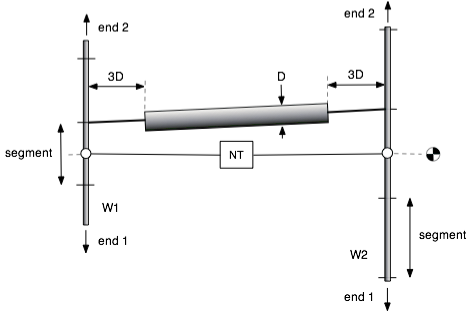
The two ends of the coax are connect to the middle of wire W1 and wire W2 . The NT box is the NEC NT (network) card that is explained in the earlier CoaxTransmission Line Models section.
NEC inserts sources, networks and transmission lines at the middle of a wire segment. The middle of the center segment of the each wire is shown above as an open circle.
On the other hand, NEC connects wires at the end of segments. For this reason, NEC cannot attach both the center of the shield and the center of the inner conductor of the coax to the same precise location on a wire.
As shown in the diagram above, the NT card is inserted between the middle of W1 and the middle of W2, while the outer shield of the coax is modeled as a fat wire with diameter D that is connected to one of the ends of the central segment of each wire. The structure length of the shield is 6D shorter than the connecting distance between W1 and W2. A tapered wire connects the shortened shield to W1 and W2. The model becomes come accurate as the segment sizes of W1 and W2 are made smaller, since the distance from the NT connections and the shield connects become smaller.
By convention, cocoaNEC connects the shield to the end of a wire segment that is closer to end 2 of W1 and W2. end 2 is the second set of coordinates that is used to define a wire. If a crossed coax connection is requested, in addition to a phase reversal of the NT card, the coax shield is connected to the end of a segment that is closer to end 1 of W2.
NC Functions for creating Coax Cables With Shields
The function arguments for the coax models which include shields are the same as the function arguments for the functions where shields are not generated.
coaxWithShield( element1, element2, type )
crossedCoaxWithShield( element1, element2, type )
terminatedCoaxWithShield( element1, element2, type, y1r, y1i, y2r, y2i )
crossedTerminatedCoaxWithShield( element1, element2, type, y1r, y1i, y2r, y2i )
These functions should not be used with twin-lead coaxtypes.
The following is an example of using the coaxWithShield function to model the common mode currents on the shield of a coax cable that feeds a horizontal dipole:model( "common mode radiation example" )
{element wLeft, w1, wRight, w2 ;
}
float span, height, d ;
span = 5.2 ;
height = 5.6 ;
d = 0.1 ;
// dipole
wLeft = wire( -span, 0, height, -d, 0, height, #14, 21 ) ;
w1 = wire( -d, 0, height, d, 0, height, #14, 5 ) ;
wRight = wire( d, 0, height, span, 0, height, #14, 21 ) ;
// coax end
w2 = wire( -d, 0, 0.5, d, 0, 0.5, #14, 5 ) ;
voltageFeed( w2, 1, 0 ) ;
coaxWithShield( w1, w2, RG8 ) ;
freespace() ;
The azimuth radiation pattern in the left hand figure below is produced by the example code above. Notice the strong laterally unsymmetrical vertical polarization component and a slight skew for the horizontal polarization. The right hand figure uses the coax function instead of the coaxWithShield function. (Horizontal polarization is shown in solid lines, and vertical polarization is shown in dashed lines.)
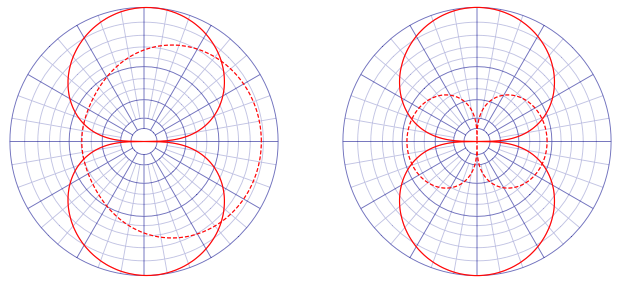
NC Functions for End feeding Shielded Coax Cables
Instead of connecting the coax at the middle of a wire, the following functions allows you to choose to connect to the middle or to either end of a wire. Connecting to the ends of wires lets you connect the coax axially, as shown below (connecting end2 of wire W1 to end1 of wire W2):

endFedCoax( element1, end1, element2, end2, type )
endFedTerminatedCoax( element1, end1, element2, end2, type, y1r, y1i, y2r, y2i )
end1 and end2 are integer values that are either 0, 1, 2, 10, 11 or 12.
The least significant digit of end1 or end2 specifies the location of the wire the coax cable is connected to.
A location value of 0 connects the coax to the middle of the wire as in earlier coax functions. A value of 1 for end1 connects the coax to the start of wire element1. A value of 2 for end1 connects the coax to the end of wire element1 (the start of a wire is the first set of coordinates when a wire is created).
Likewise, the least significant digit of end2 selects whether you want to connect the coax to the middle or either end of element2 .
The tens digit of the end1 and end2 flags indicate if the shield is to be left disconnected (this lets you easily model axial stubs that are found in antennas that uses the shield of a cable as radiating elements). If a non-zero flag value is seen, the shield at that end of the coax cable is left unconnected to the wire, i.e., the short wire of length 3D in the above diagram will be left out.
If the shield flag exists on both end1 and end2, the entire shield wire in the model is also left out.
When endFed coax functions are used with twin-lead coaxtypes, the shield flags are set automatically (twin leads have no shield).
Insulated Wire Extensions
cocoaNEC provides alternate ways to represent an insulated wire other than the IS (insulated sheath) card in NEC-4 and for users of NEC-2, where the IS card is not implemented.
The following NC function implements the approximation by Alexander Yurkov (RA9MB), http://www.qsl.net/ra9mb/nec.pdf with 0.92 as the velocity factor for the Yurkov insulation.
yurkovInsulate( element, permittivity, radius, velocityFactor )
- yurkovInsulate is similar to the insulate() function in NC, but always uses the Yurkov approximation even when running with NEC-4. See http://www.qsl.net/ra9mb/nec.pdf .
cebikInsulate( element, permittivity, radius )
- The Cebik approximation for insulated wires is similar to the Yurkov approximation above, but uses L. B. Cebik's approximation. See http://www.antennex.com/w4rnl/col0105/amod83.html .